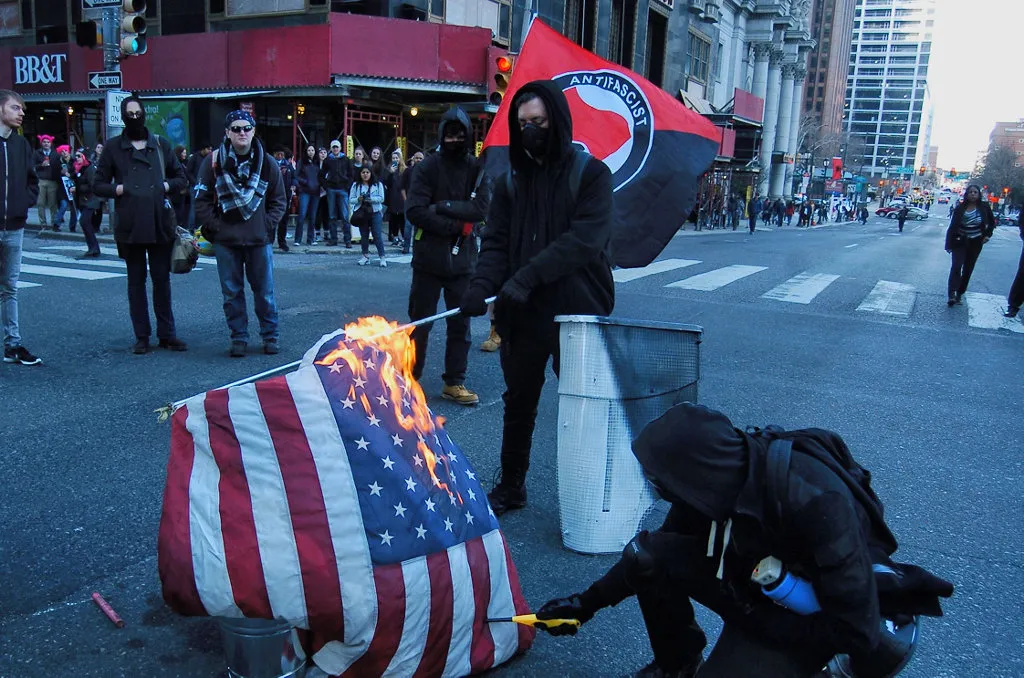Texas v. Johnson – 1st Amendment
Summary of a First Amendment Landmark Supreme Court case: Texas v. Johnson 491 U.S. 397 (1989)(link is external)
Facts:
While the Republican National Convention was taking place in Dallas in 1984, Gregory Lee Johnson participated in a political demonstration dubbed the “Republican War Chest Tour.” The purpose of the demonstration was to protest the policies of the Reagan administration and of certain Dallas-based corporations.
The demonstrators marched through streets, chanted political slogans, and stopped at several corporate locations to stage “die-ins” intended to dramatize the consequences of nuclear war. At one point, Johnson accepted an American flag handed to him by a fellow protestor who had taken it from a flagpole outside one of the targeted buildings.
The demonstration ended in front of Dallas City Hall, where Johnson unfurled the American flag, doused it with kerosene, and set it on fire. While the flag burned, the protestors chanted: “America, the red, white, and blue, we spit on you.” No one was physically injured or threatened with injury, though several witnesses testified that they had been seriously offended by the flag burning.
Johnson was arrested and charged with violating a Texas statute that prevented the desecration of a venerated object, including the American flag, if the person knows it will seriously offend others. A Texas court tried and convicted Johnson. He appealed, arguing that his actions were “symbolic speech” protected by the First Amendment. The Supreme Court agreed to hear his case.
Issue:
Whether flag burning constitutes “symbolic speech” protected by the First Amendment.
Ruling:
Yes.
Reasoning:
(Brennan, J.) The majority of the Court, agreed with Johnson and held that flag burning constitutes a form of “symbolic speech” that is protected by the First Amendment. “A law directed at the communicative nature of conduct must, like a law directed at speech itself, be justified by the substantial showing of need that the First Amendment requires.”
The majority concluded that the Texas law impermissibly discriminated upon viewpoint. The Court noted, “If there is a bedrock principle underlying the First Amendment, it is that the government may not prohibit the expression of an idea simply because society finds the idea itself offensive or disagreeable.” For example, although the law punished actions, such as flag burning, that might arouse anger in others, it specifically exempted from prosecution actions that were respectful of venerated objects, e.g., burning and burying a worn-out flag. The majority said that the government could not discriminate in this manner based solely upon what message was communicated.
Finally, the Court concluded that Texas’ interest in preventing breaches of the peace did not support Johnson’s conviction because the conduct at issue did not threaten to disturb the peace. Moreover, Texas’ interest in preserving the flag as a symbol of nationhood and national unity did not justify Johnson’s criminal conviction for engaging in political expression.
Dissent:
(Chief Justice Rehnquist) Writing for the dissent, Chief Justice Rehnquist recounted the historic role the flag has played and asserted that it is a visible symbol embodying the nation that represents neither a particular political party nor a particular political philosophy. The dissent further contended that the public burning of the American flag by Johnson was no essential part of any exposition of ideas and had a tendency to incite a breach of the peace. Therefore, because the American flag has occupied a unique position as the symbol of the nation, that uniqueness justifies a governmental prohibition against flag burning.
(Stevens, J.) Justice Stevens argued that the flag’s unique status as a symbol of freedom, equal opportunity, religious tolerance, and good will for others who share such operations supports a prohibition on the desecration of the American flag in the same way that the public is prohibited from spray painting the Washington Monument or the Lincoln Memorial.


